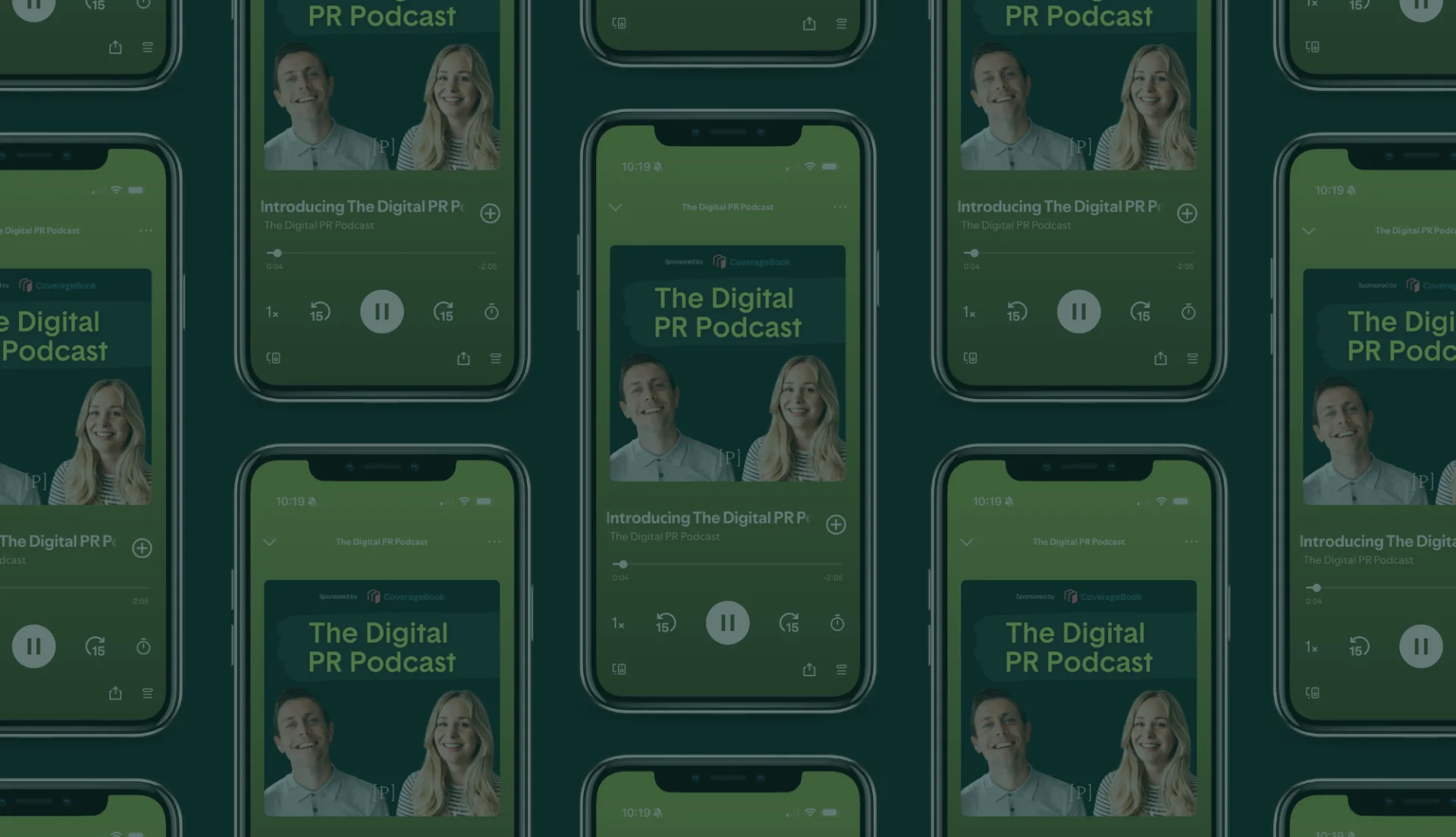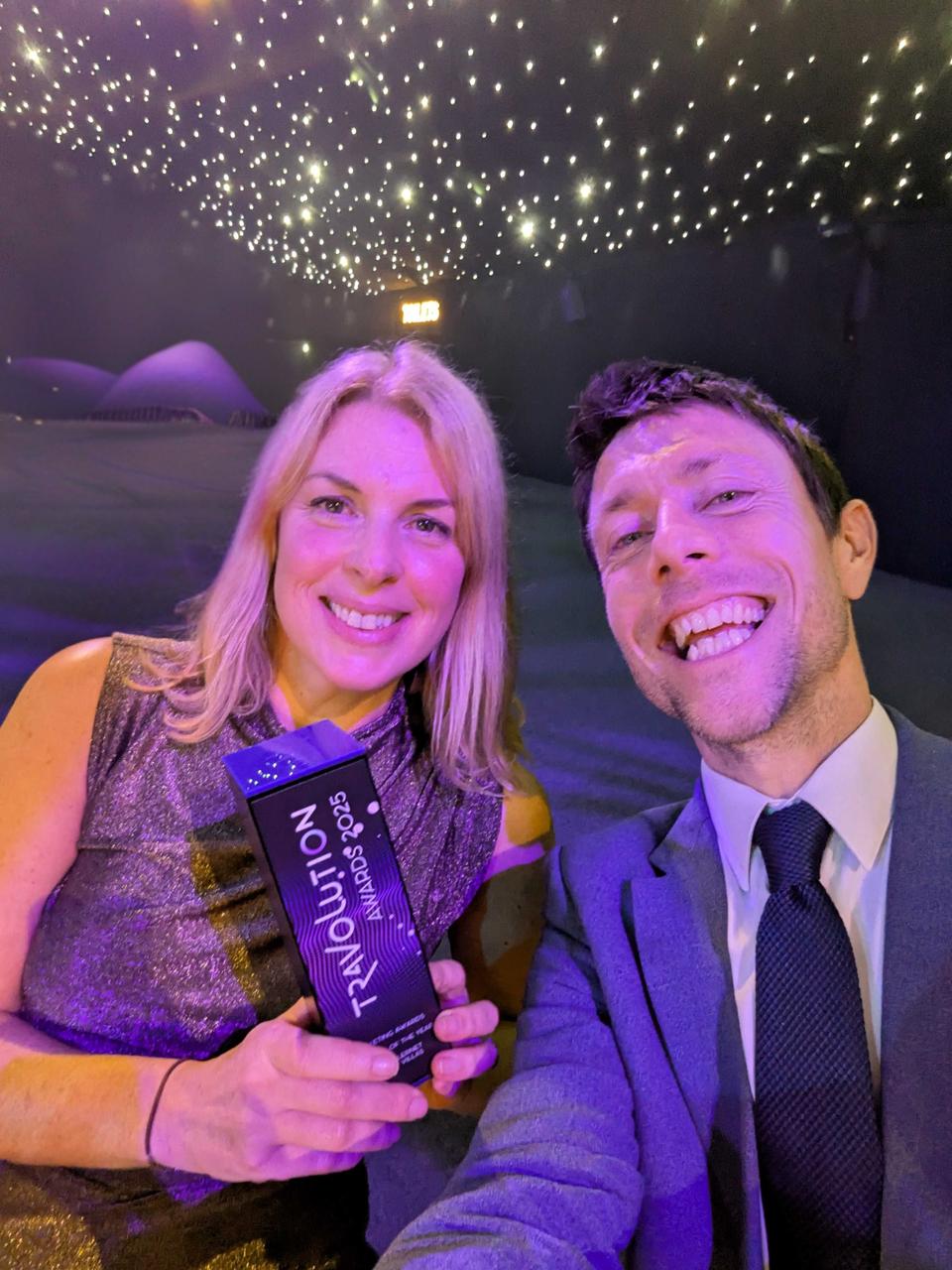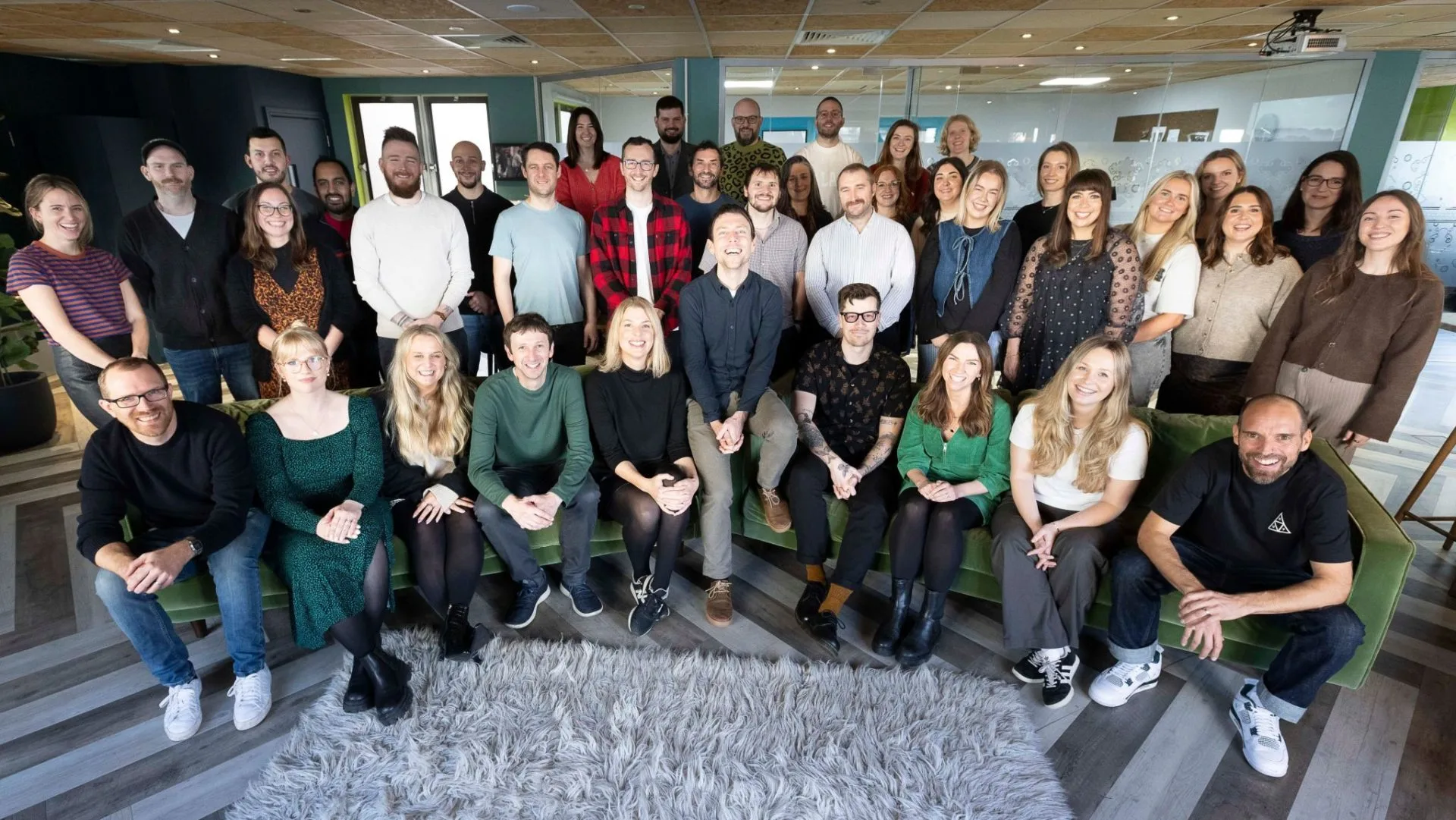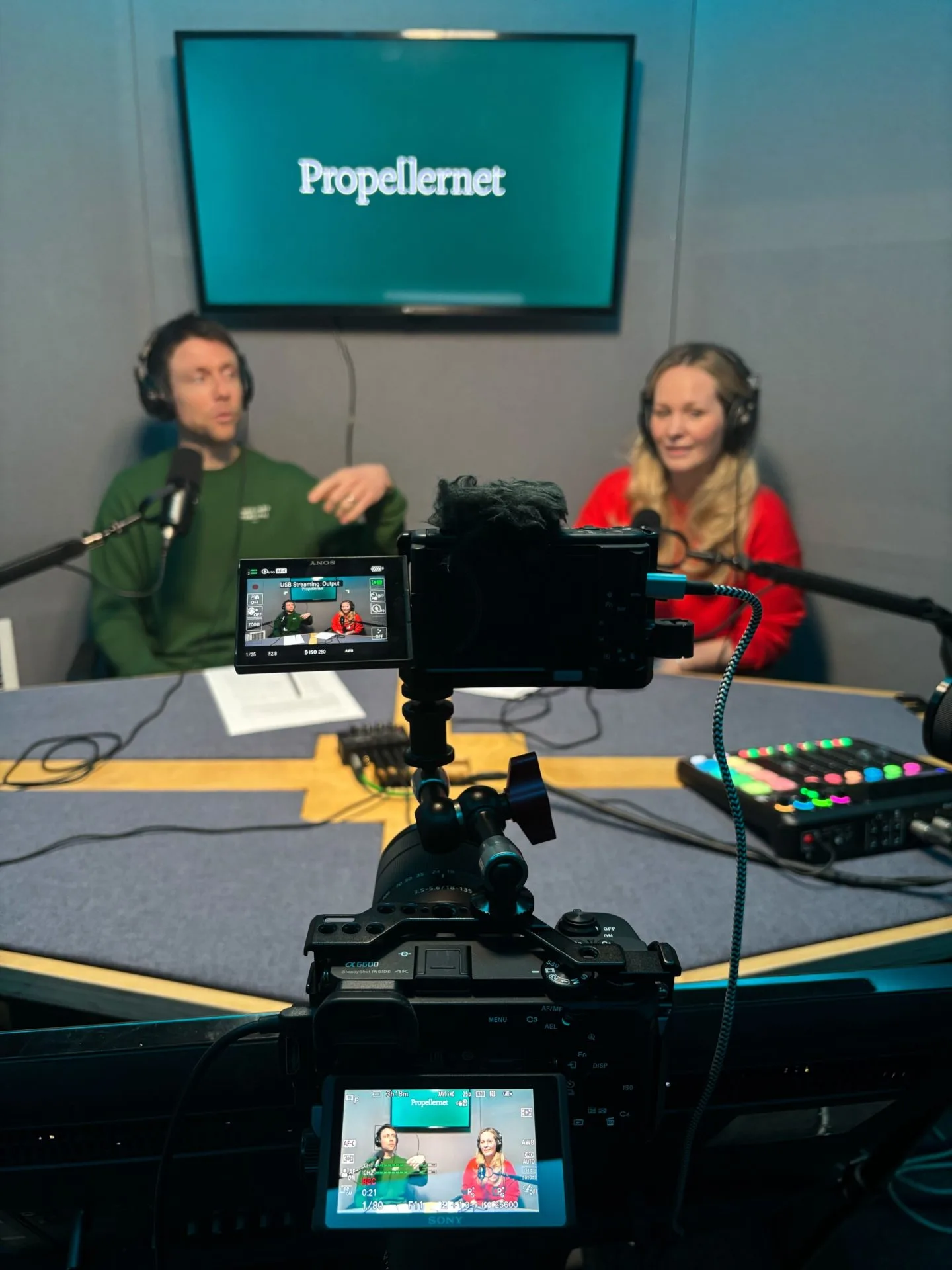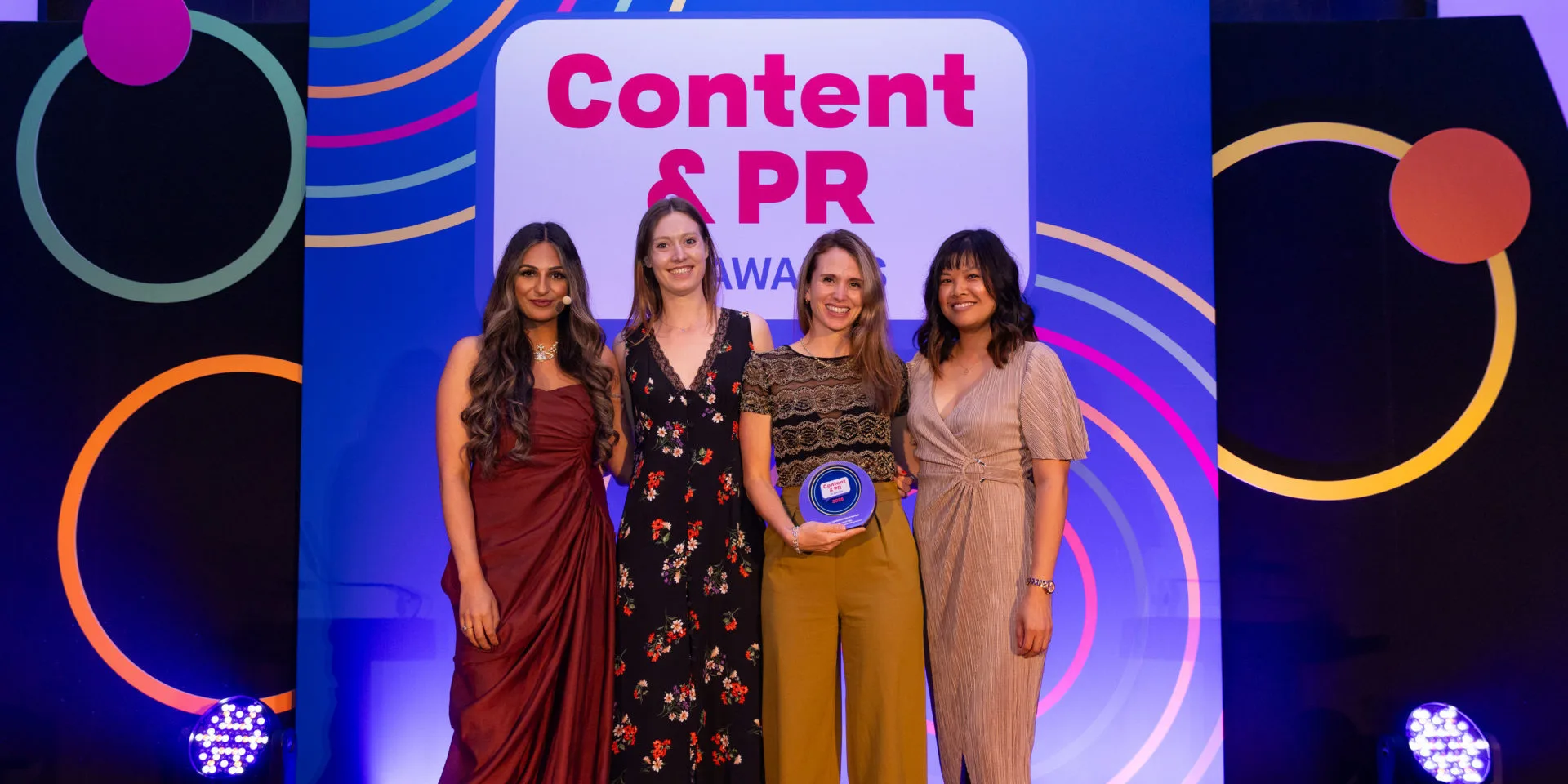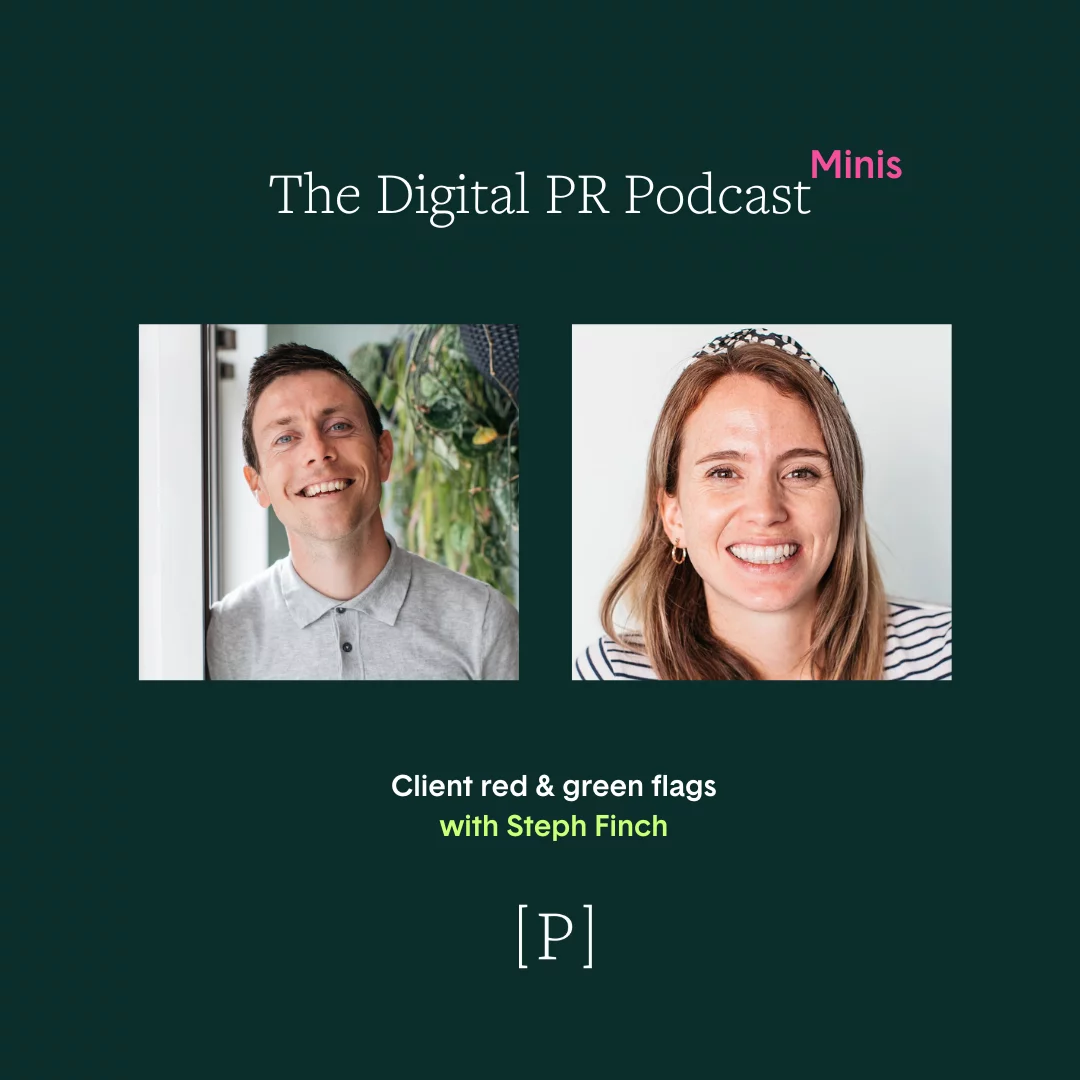
In episode three Steph Finch, our very own PR director, talks us through her biggest red and green flags for clients in her 10 years of experience in PR. We talk early signs of a good client, behavioural patterns and breaking down how the PR world has changed over her many years in the industry. Have a listen or you can read the summary of AI transcript below.
Go back to all episodes0:00:07 – Stephen Baker
Hello and welcome to the Digital PR Podcast. I’m Steve Baker and my co-host, Lou, is off doing the rather more important job of raising a tiny human, but the show must go on. We’re in between seasons at the moment, but we thought we’d give you all a little treat by bringing back our mini episodes. Throughout June and July, we’ll be jumping into all of PR land’s hottest topics, as we always do, and hearing from members of the Propellernet PR team on everything from pitching to personality types. So get the kettle on, get those headphones charged and make sure to subscribe so that you don’t miss any of our episodes. We’re joined today by our brilliant PR director, Stephanie Finch. Steph, welcome back. Thank you for joining.
0:00:51 – Steph Finch
Thank you for having me back.
0:00:54 – Stephen Baker
Always a pleasure to chat to you in these kinds of circumstances, just generally about what’s red and green flags when working with clients, which is, I guess, probably one of the most discussed topics in agency land. And, as a, I’m worried how you’re going to take this phrase, seasoned digital PR veteran, are you comfortable with being called a veteran?
0:01:16 – Steph Finch
I have to be, I suppose yes, 10 years plus in the industry mid-30s and only done digital PR. I’m a veteran.
0:01:28 – Stephen Baker
You are. Okay, we’re going with a digital PR veteran. We’ve worked together for a decade. I mean I know you’ve had loads of exposure to client-agency relationships and more than most, would you say? Let’s start with this question. Would you say the client-agency dynamic has changed at all over the past 5 to 10 years since you’ve been working in digital PR as the industry’s grown?
0:01:48 – Steph Finch
Well, yes, in short, I do. So for context to what you said, I am a bit of a veteran, I started in 2012, PR has definitely changed in that time quite considerably. In my early days, it wasn’t even called digital PR. There wasn’t really a label for what we did, which was sort of leveraging PR tactics to build link at a time when everyone called it different things. We’ve now settled on digital PR. I still don’t like that name, but that’s a different moan for a different podcast episode.
I know I always say that I don’t like that we call it that because it’s really weird but anyway, agency client dynamics. The evolution of them in the last 10 years. Well, 10 years ago we were speaking like our day-to-day clients were. This is sort of in the late noughties and early tens where people who were responsible for the SEO of a website were responsible for organic traffic, organic conversions. So their KPIs and what we reported back to them heavily focused around link types. Was it a followed link? Was it a category link? We knew what the anchor text of the link was back in that day, that was something we could have a little bit more control over and wasn’t sort of like a spammy signal.
And then the way we secured those links, the clients weren’t that involved in or particularly interested in. That was why they hired us, because we knew how to speak to journalists and we knew how to employ these PR tactics to secure links and they didn’t mind how we got the message to journalists. They weren’t too worried about the brand message of a campaign. It was like, hey, you’ve got a link on Cosmo. We don’t care what magic you’ve done to get that, we’re just we’re loving that we’ve got a category link on Cosmo. Fast forward five years- then we started to be noticed by brand teams and PR teams because we’re landing coverage on national and major lifestyle sites.
Then I feel like there was a bit of a restriction and the dynamic changed quite considerably in the mid-10s onwards, I would suggest, where there was much more scrutiny on the work we were doing and PR teams were getting involved, because we were landing PR coverage but they didn’t understand why we were doing it like that. It was different, and sort of why an SEO thing had to involve speaking to journalists. Then fast forward another five years, we come full circle where everyone’s got much more freedom. I think brand teams and PR teams internally understand that digital PR teams know how to speak to journalists and are a safe pair of hands at handling those relationships. So, in terms of how the dynamic has changed over 10 years, before we were dealing with maybe one or two people with quite a technical background and now we tend to speak to two or three teams. We’ve got the e-commerce team, the SEO team, the brand team, social team, PR team. So yeah, that’s how the dynamic has changed. It’s got a lot busier.
0:04:46 – Stephen Baker
That’s a lovely, neat summary of it. It’s got a lot busier, it has. Let’s go back to the start, or sort of the beginning. You’ve won a new client. Well done, you’re going to have an onboarding process. What, in your opinion, is a sign early on during that that you might be in for a bit of a tricky ride and vice versa? What’s an early sign that makes you excited about working with a client?
0:05:18 – Steph Finch
I like that. So when you said “you won a client”, I was really into the sort of improv scene of “I won a client! “This is so exciting, let’s go!” But what I wanted to say for the listeners benefit is that I will be framing my answers so that all of my answers, I think, are true. Whether it’s a start-up challenger brand that we’ve won, or if it’s a massive corporation, I think the patterns of behaviour, the red flags and green flags that come up, aren’t actually really different. There’s obviously very different dynamics working with a start-up to a massive established limited company, but I think the same patterns of behaviour can be seen across the board.
These are just patterns of behaviour that we see and I think over 10 years we start to see these patterns. So when it comes to onboarding processes, in particular those early days, obviously the pitch is a massive part of it and you’re involved quite heavily in new business and pitching and I know that back in the day, like a long time ago eight or seven years ago you know informally, in the office we would say like we just “don’t work with dickheads”, like “our policy is no dickheads”, which is obviously difficult and it’s not a fail-safe way to win new business. But we are very blessed that we do seem to only partner with and collaborate with brands, which are quite nice. So but that’s a separate podcast again – the pitch process – but let’s say we’ve onboarded them early days.
One pattern of behaviour that pops up that does now make my stomach knot a little bit is when you have the first onboarding call and it may just be your main client, or two of them, and it’s like super high energy and they’re really funny and they’re really smart and you’re like, oh, my god, this is great, they totally get it and we’re gonna do some like really cool work with them. And they are talking, they’re excited, they’re like “please, push us. We want to do everything to make viral campaigns”, “push us, push us, give us your biggest ideas”, like the sort of ideas that you might give another client, that are a bit more safe, ”We want really super exciting ideas”. Then you finish the call, you’re buzzing and you’re loving life and you can’t wait to get started. And you go and do all the admin, you set the Slack channels and you put in the fortnight calls and you send them an email with all the actions like: “yeah, do you remember? You said that thing and we’re going to go and do that right away because that’s great.” And then there’s nothing and you just don’t hear from them again for like a week for two weeks, and you’re following up and suddenly all that excitement and potential is just gone.
And it does seem to be a bit of a pattern when people are on in person, they can be so ready to do great work, but then, when it actually comes to the sort of tedious day-to-day, there’s suddenly radio silence. So that can be that’s a pattern I’ve noticed over the years I’ve worked, that can be a bit of a red flag on the other hand. So I guess then, like a green flag, the converse of that is having quite a nice steady intro call, like if they’re a bit nervous or a bit hesitant, that’s almost like a better sign that at least they understand what the next actions are, because it does involve some work. A really good green flag, I think, is when they invite other stakeholders to those early calls. So when the onboarding calls involve the PR team or the brand team or social team or whatever other team wants to get involved, it can mean that these calls take longer or that there are more of them.
And sometimes you have to re-explain what digital PR is and what we want to do and why we want to do it, and you can feel like, oh God, this is going to take ages to actually get anything off the ground but I sort of prefer that because in my experience then it’s safer once you have gone through that process and you’re up and running you’re going to keep going. I call them tank clients like a big army tank, because it takes a lot of energy and patience to get it moving, but then once they’re on the roll it just can’t be stopped and it keeps rolling.
0:09:29 – Stephen Baker
I’ve never heard you use that phrase before, but I like it. I like it a lot. You’re right in that we can’t assume with clients just as they can’t assume with us. You know, everyone’s different, every setup is slightly different and you referenced they’re working with quite a lot of people at once and everyone has different knowledge and range of experience. With regards to digital PR and working with digital PR agencies, thinking specifically about digital PR, what in your experience do clients do that make it kind of clear that there’s maybe a bit of a knowledge gap when it comes to how it works? I do think a large part of what we do is down to education at the, at the first bit, like from the pitch stage, to actually starting work. But what in your experience shows that slight lack of knowledge or a bit of a knowledge gap?
0:10:19 – Steph Finch
SEO PR is where the biggest knowledge gaps tend to be. We still get this happen, maybe more five years ago, but it can still happen when clients ask us to change a nofollow link to a follow link or change an affiliate link to a follow link, that does flag that. It flags that that client has had no real first-hand experience perhaps with speaking to journalists or really understanding what it’s like to be a journalist and to be in their shoes and you’re being tasked to create pieces of you know 10 content articles for your news publication a day. You have absolutely no say over the kind of linking code that goes over your piece of writing at all. And so, yeah, that sort of naivety perhaps to how the publishing world works can be flagged a bit when people are like” oh, can you just change the kind of link?” And it’s different to ask if you need to ask for a link to be put in as credit. That’s a separate comment. That’s fine, because I think that is normal. You can ask that of a journalist, but to ask a journalist to understand their coding and change the coding of a link that’s been put into an article at their discretion or not. It’s not right, it’s too much for the journalist and asking that of them is a bit naive, I would say.
Something else which shows a bit of naivety around how PR works is when we get press releases and they keep wanting to add more and more and more company info into the press release. It almost then starts reading like an about us section of their website and the story and the hook that we’ve created gets lost because they want to talk about all the initiatives and how great this company is and it just ends up reading like, sort of sticking the boilerplate within the main part of the email so that again flags up. Okay, so you probably don’t pitch a lot, because then you would understand that having too much of that kind of information in the main body of the release completely swamps your story. So yeah, those sort of two different knowledge gaps. I suppose the more technical one is when they ask you to change link code, or ask you to ask a journalist to change link code, or they just completely spam your release with too much brand info. That kills your story.
0:12:53 – Stephen Baker
I’ve been there, I’ve been there. I think we all have. You referenced at the start about digital PR, the world of digital PR I guess it’s got busier is what you said. So what we have had lots of over the years, is lots of different examples with clients that have in-house marketing teams or other agencies that they work with, whether that be kind of advertising, traditional PR et cetera, that we would work alongside, and sometimes an agency gets brought in to run the whole show. What’s one of the main difficulties that you have or have experienced when working with brands that are protective that can make it difficult to get the ball rolling on kind of campaigns and stories?
0:13:44 – Steph Finch
This question is a tricky one to answer because what we have to remember is that promoting whilst protecting a brand is actually a really difficult job. It is very tricky so naturally, between brand teams and PR teams there will be a bit of conflict, there will be times where how we reach our KPIs conflicts or clash a bit. For example, we worked with a a walking holidays client and that film, Cocaine Bear, had come out and we were like, oh my god, let’s go out with a story about where the most bear attacks happen in North America or where you’re most likely to be killed by a bear. Naturally, the brand team’s like, absolutely, I think not, we’re not going to associate. We can’t go out talking about bears killing people when we want to talk about exciting, life-fulfilling, lovely walking holidays, which is fine and we we did do it as a bit tongue-in-cheek and that was one of the early days where you’re sounding out risk levels or how protective of a brand they are and any digital pr team worth their salt will understand that. Obviously that is not a sensible idea to suggest when you’re trying to sell a walking holiday, but they totally understood why this will get covered and go everywhere, but we’re not doing it from a brand message point of view and it was just cut and dry. Then it’s we learn. Okay, that’s not the kind of thing they were going to sign off on and we didn’t waste any time preparing that idea or doing that idea. We just moved on to the next stage with this new learning.
The main difficulty, I think, sometimes with working with quite protective internal brand teams isn’t when they just say no straight away. In fact, that’s quite useful. What is worse is that death by a thousand cuts. So when we present an idea and in that ideas presentation we feel like we’ve made the case that this idea is really relevant to your brand, it’s really relevant to your audience, and it’s going to get media cut through as well and everyone in the room at the time is like yeah, yeah, great, great, great, sign it off, and then later down the line, once we’ve started investing time into, you know, running studies, running surveys, methodologies, and then we get these tiny little oh, actually we don’t want to talk about this.
Things like actually we don’t want to include that sort of audience in the survey, or actually we don’t want that angle because it feels like we might offend potential customers. And at the time you’re like, oh, yeah, no, that’s fine, because it’s just a little tweak, and it’s just a little tweak, and it’s just another little tweak. And then eventually at the end you have this release that’s got no killer hook, no exciting methodology, no real opinion or comment about the findings, and then it obviously doesn’t get any coverage, and so that’s sort of a difficult process. But you have to head that off sooner rather than later. But because it is just these little tweaks, at the time it can sneak up on you yeah, I know, yeah, it’s a good way of putting it.
0:17:04 – Stephen Baker
Actually it’s often not like a major change, it’s just like cumulative little things that can water something down beyond it being useful. But I’m going to ask you almost the reverse of that question. So when it’s right and I agree, it’s a really hard job to protect a brand, to work alongside sort of other agencies to sort of figure out what they’re doing, make sure you’re comfortable with it but when you get it right, that kind of smooth integration between the client and agency kind of PR marketing teams you’ve got a lot of experience in that and you recently wrote a great piece for the industry publication Prowly about everyone.
0:17:40 – Steph Finch
Go read about how to work with internal PR teams on prowly.com. Do go and have a read.
0:17:45 – Stephen Baker
It’s a good one. But what are the things that make your job easier when working with clients? So we touched on the things that might make it more difficult, but what are the things that make it easier?
0:17:53 – Steph Finch
From the off. If your day to day client doesn’t invite the brand team or the internal pr team or representative to a call, ask for them to be invited. But when they invite them themselves, that’s such a lovely green flag. It shows they understand the pr element of digital pr. The other side is the reporting and the technical SEO and why we want these links and why are these brand mentions important. But working with people who do the same tactics as you. A traditional PR internal team or even agency will have different objectives to us, but the work we do ends up looking very similar. So we have a lot of shared experience about like knowing which stories will fly and understanding how hard it is to land coverage, and so then when the coverage lands, they celebrate that with you.
I feel like when you get a pat on the back or a slack emoji from the PR team when you’ve landed something on a national and it might not have a link or there might be no follow, but they’re like, oh my God, this is brilliant because it’s the brand message and it mentions us that it’s on the Metro, and you’re like, yes, so yeah, inviting the PR team as early as possible, really, and I think, another green flag.
I’m not ever disappointed when people ask to share media lists, because that’s such a good proof point that they’re pitching to media and they understand the pitching landscape, because then they will understand what it’s like to be in our shoes as well, and it also shows that they’re careful about overlap and they value their relationships with journalists and the fact that, being professional and careful, it’s just a lovely sign that they’re going to give the same respect to our work as well.
And then another one which does happen from time to time, which I do really like, is inviting us to internal brainstorms or internal status updates, where it’ll be across the board marketing call and we won’t be necessarily a massively active participant in those calls, but it just gives us a view of what is happening internally, like what it’s like to be our client and you know the people they’re working with, the other sort of teams and colleagues they have, what ideas are being brought to the table, what pressures they have working within that company, and just really helps us understand them more and then that makes our work better for them because we understand the other conversations that they’re having when they’re not talking to us.
0:20:34 – Stephen Baker
You touched upon the creative process there, so just to stick with that for a second. When it comes to clients and the creative process, what’s like the dream scenario for you, like what should, in your ideal world, clients be doing to sort of make the absolute most of that and our creative talents?
0:20:54 – Steph Finch
It’s a good question because I feel like so much of that is on us to be the creative minds and to come up with the idea that blows them out of the water. It’s obvious, it’s a cliche, but it’s when the collaboration happens, when clients bring their builds to us. I have two examples. One off the top of my head was when we presented to our client scrap car comparison, this idea that people were very stressed with the pandemic and were feeling very ragey and we could give them the chance to go and beat up a car, perhaps with a baseball bat or something like that. And the client was like, yeah, no, that’s cool, except what if we know some guy who has tanks? What if we blew up a car instead? And it was that sort of like, yeah.
We’ve had another one as well. We work with a travel client, and we were working on a David Attenborough piece about how influential he is on people’s travel, and they were really excited about it. And they’re like, yeah, we want to create this David Attenborough comparison tool. But they were also thinking that would be great for our newsletter content, for our social content, for customer retention and our content teams, and so it’s great they have these ideas. But what was very specific about those two lovely clients is that they went and did it. They invested time, they sought out, they delivered on what they said they would do in the creative moment and we all benefited from it. It all benefited from it.
0:23:20 – Stephen Baker
Yes, I totally agree. But I think the worst case scenario is where you’re just seen as a commodity, where it’s like just give me ideas, which is obviously what we’re paid to do, and that’s fine. Yes, but where?
Before we finish I want to ask you one more question about reporting and then ask you for your three things or top tips, I suppose, let’s just talk about reporting first. So at the start, we talked about how digital PR has kind of evolved quite a lot, and it used to be a lot more like the number of links and DA scores and, like you know, anchor text matches and things like that. Some clients obviously still kind of get wrapped up with those metrics when it comes to deciding what is and isn’t good coverage or good links. What’s your opinion? It’s something I know we have discussed internally as well, but what’s your opinion on clients wanting to set a link target for a campaign? Is it a red or a green flag for you?
0:25:20 – Steph Finch
I don’t think it’s a red or green flag. I think it’s a good way. I think if it’s collaborative, if they come up and they say we think the link target is 100 links per campaign and there’s no sort of negotiation or conversation around that, that’s an obvious red flag. It’s nice when they say could you set a link target? And they leave it to us to set our own.
We’re obviously very honest, so I don’t mind and they keep us honest. I think link targets and they help manage expectations. I think the important word in link target is target, like a lot of people think that’s a minimum and it’s like it’s a target and obviously not all the links are equal. So we could have a target of 15 links but say we only got seven, but they were all follow links to a category page on relevant sites and it’s like, come on, that’s that’s pretty good and I think if you have a healthy communicative relationship with your client, then that works.
One thing I find so incredibly useful is not having a link target like a hard link target per piece of work, but rather having a link target that covers a number of different pieces of activity and it gives you a safe and it is the nature of pr and if you work with someone with pr experience client side, they understand that too where you’re like look, we’ll do six pieces of work, two are going to go really, really well, two are not going to get anything and two are going to average out. So like on average, that’s you know whatever 20 links per campaign, but as a whole package. So it’s over 100 links, but making sure it’s okay that one hasn’t worked the next one well. It obviously puts more pressure on the ones coming up, but it makes conversations easier like okay, if this one just isn’t going, let’s try something new and not get hung up wasting time trying to flog a dead horse.
0:27:25 – Stephen Baker
Let’s end then with you, Steph, thinking about the best client relationship you’ve ever had in your career. You don’t have to name them, in fact, definitely don’t name them, just think about them and sit here and name some lovely people, just list clients you’ve had. What are the three things that made that client a dream to work with?
0:27:53 – Steph Finch
I didn’t mean for these all to start with p, but they do okay. Interesting pr experience, but that’s it, because we don’t do it all the time. So sometimes we do have clients who have first-hand experience and then they’ve learned the like on the digital part afterwards. That client’s a dream because they understand the pressures and nuances of working in pr? But equally it can be sort of teams where you have an SEO client and a PR contact as well and they obviously work closely together and well together, and then that sort of serves the same purpose. So PR experience, definitely. The next one’s patience. The best kind of relationships are the ones where they don’t, I’m aware this contradicts a little bit where they completely fall off the map after the first call, Don’t do that. but give us space to work and trusting the process, I think, definitely bears the best results for clients. The way we work is nice because we’re very honest people. We always want to do the best for clients and if you feel like they trust you, then you’re going to work a bit harder for them.
Then the third one is like, just to be prepared to take calculated risks. I guess so, not you know you’re not going to get any fun coverage about doing something exciting. I don’t know whether it’s a dream job or smashing stuff up or offering exciting trips. If you’re worried about what if they get hurt whilst they’re doing this thing? It’s okay, but then nothing will happen. That sort of mindset means nothing will happen. So yeah, just being prepared to take a little bit of a risk.
0:29:58 – Stephen Baker
Should the listeners keep an eye out for your upcoming book, the three p’s of client relations
0:30:08 – Steph Finch
They should. Maybe that’ll be my next blog post okay, beautiful.
0:30:13 – Stephen Baker
Stephanie Finch. A pleasure as always. Thank you so much for joining us to discuss client red and green flags. It’s been a pleasure.
0:30:21 – Steph Finch
Thanks for listening. Thank you, Mr Baker, for having me. I will see you soon.
